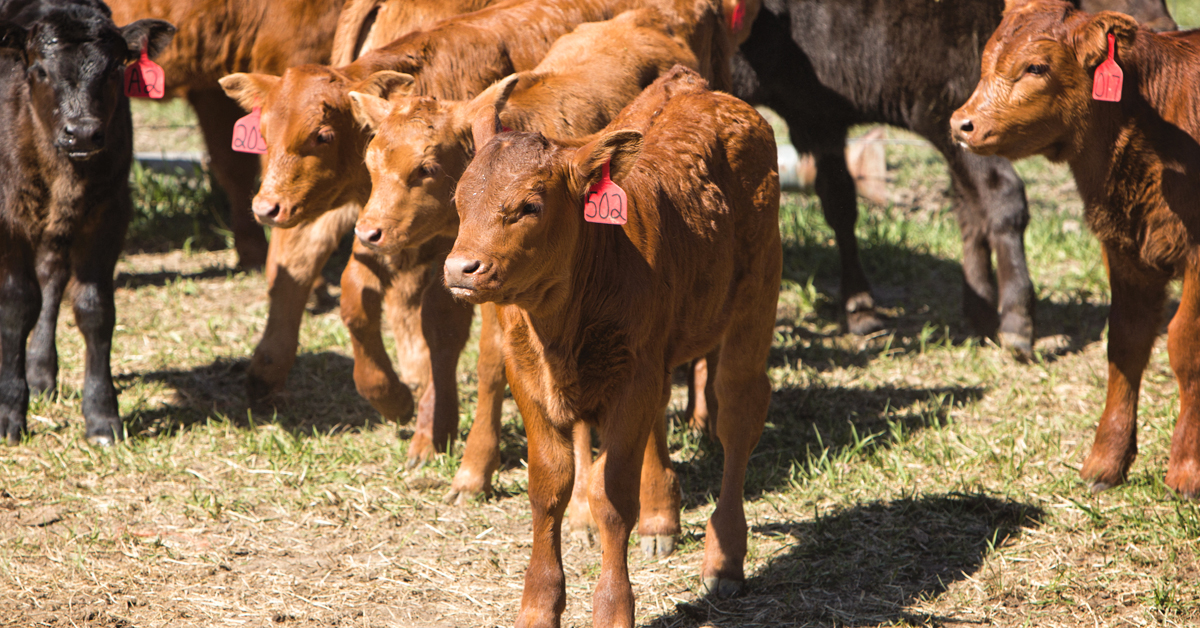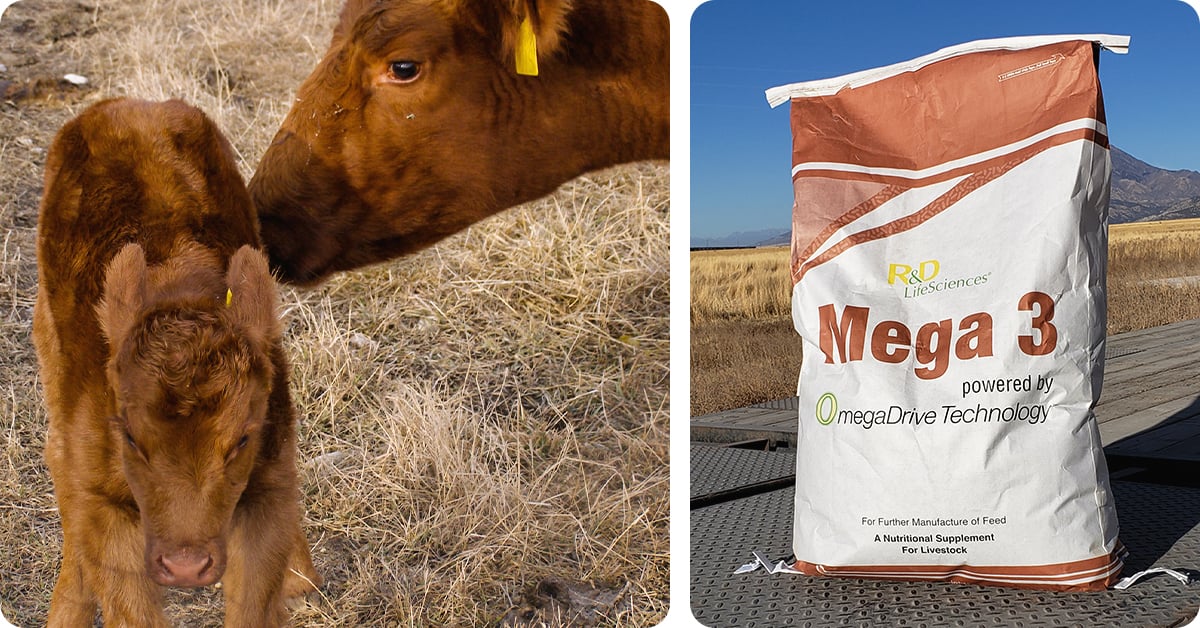
Reproduction in beef cattle is a topic that generates a great deal of conversation. Reproductive failure leads to great losses in the beef industry.
The sustainability of many beef operations depend upon achieving greater reproductive success than the industry standard. In order to be successful reproductively, ranch management and nutrition are extremely vital.
Some keys to proper nutrition and management:
- Ensuring that the diet has adequate energy and protein prior to calving
- Post-weaning nutrition to decrease days of anestrus
- Proper nutrition to ensure cows and heifers are gaining body condition before calving
- Feeding specific feeds to help ensure proper reproduction
Many operations have good nutrition and management but lack feeding specific feeds to help increase fertility. Recently, research has focused on the benefits of feeding specific fats high in Omega-3s to help with reproduction.
Omega-3s Role in Nutrition
Fatty acids are crucial in all aspects of nutrition and not all fats are created equal. Supplementation of fatty acids can affect cellular function, reproduction, and health of the animal. Cell membranes are made up of fatty acids and the proper function of the cell is dependent upon the profile of the fatty acids.
The body has the ability to build certain fatty acids from scratch but others called essential fatty acids need to be supplemented in the body. Other fatty acids can be modified in the body if certain fatty acids are present to build upon.
Two main fatty acid groups that are essential and need to be supplemented in the diet are the Omega-3 and Omega-6 families. Omega-3 and Omega-6 fatty acids aid in reproduction by aiding in fertility and cycling of cattle.
Omega-6 fats are pro-inflammatory, whereas, Omega-3 fats are anti-inflammatory. Both fats are needed; however, the over-supplementation of one will inhibit the response of the other.
Corn, soy and corn byproducts are generally high in Omega-6 fats. Most western diets contain some type of corn product in them, which generally leads to higher amounts of Omega-6 fats in the diet. Feeds such as flax and fishmeal contain greater amounts of Omega-3 fats.
Start feeding Omega-3 with IFA's Mega 3 supplement

Heifer/Cow Reproduction
Reproduction is influenced by the nutrient profile of the diet. For example, high levels of Omega-6 fats promote the production of prostaglandin in heifers. Prostaglandin is needed to bring the cow into heat and give the cow the opportunity to get pregnant.
However, overproduction of prostaglandin will terminate the pregnancy and bring the cow back into heat. This cycle is negated if the body receives a signal that she is pregnant. Omega-3 fat on the other hand, promotes pregnancy by helping increase follicle size which leads to more production of progesterone, which tells the cow that she is pregnant.
Another benefit of supplementing Omega-3 fats that tie into reproduction is the anti-inflammatory response from the fat. After the semen fertilizes the embryo, the embryo must implant into the uterine wall to maintain pregnancy. If the pro-inflammatory response is too great, the embryo will not implant and the pregnancy will not occur.
However, feeding Omega-3 fats can increase the anti-inflammatory response and decrease early embryonic loss caused by the rejection of the implanted embryo. Omega-3 fats have been shown to improve fertility rates by 10 to 20 percent by reducing/inhibiting the release of prostaglandin, increasing progesterone levels, and decreasing early embryonic loss.
Getting cattle pregnant during the first service increases the revenue for every operation due to larger weaned calves. However, current first service pregnancy rates in the industry average around 55 percent with some of the more efficient operations getting into the 60 percent range.
With an additional 21 days to grow, gaining 2 pounds per day, you would expect about a 40-pound heavier weaned calf, which could increases revenue $50 to $60 per head. With a 10 to 20 percent increase in first service conception, the overall success of the operation looks promising.
Not only do you have the added benefit of the income, but you also have the benefit of keeping your cattle healthier. However, nutrition (ensuring proper levels of Omega-3 fat) and management are crucial for reaching higher pregnancy rates during the first service.
Bull Fertility
When it comes to reproduction in beef cattle, bull fertility is often overlooked compared to cow fertility. However, ensuring that bulls are fertile will help improve overall pregnancy rates.
One specific way to help with bull fertility is to feed bulls proper nutrients to help improve semen quality. Omega-3 fatty acids are one specific way to help increase semen quality. The production of sperm requires fatty acids and specifically Omega-3 fatty acids. The outer membrane of sperm requires greater levels of Omega-3 fatty acids, which need to be supplemented in the diet to bulls to improve quality.
Spermatogenesis (the process of producing sperm) is a 61-day process with the incorporation of Omega-3 occurring the first 25 days. Hence, increasing semen quality is a long process and needs to occur months before breeding season.
By supplementing feed high in Omega-3 fats, sperm motility increases (more athletic swimmers), there is an increased survival for live or frozen semen, and the degradation rate of the semen decreases.
Concluding Thoughts
Bringing it all together, not all fats are created equal and the intake of specific fats can improve reproduction. Omega-6 fats are required by the animal and need to be supplemented; however, over-supplementation without proper supplementation of Omega-3 fat could be doing more harm than good.
Omega-3 fats have the potential to increase the profitability of cattle operations by increasing the fertility of bulls, heifers, and cows as well as maintaining pregnancies by reducing early embryonic loss.
Intermountain Farmers Association manufactures a product high in Omega-3 fats called Mega-3. This product is high in energy and protein as well as beneficial fat for reproduction.
If you develop heifers, AI your cattle, or develop bulls, give your IFA sales team or nutrition staff a call to help determine if supplementing Mega-3 on your operation with help achieve your production goals.
Discover IFA Feed & Nutrition Services
Written by Jared Judy, PhD, IFA Feed & Nutrition Advisor at North Region Feed, and originally published in the IFA Cooperator magazine (vol. 85, no. 4) Winter 2019.

